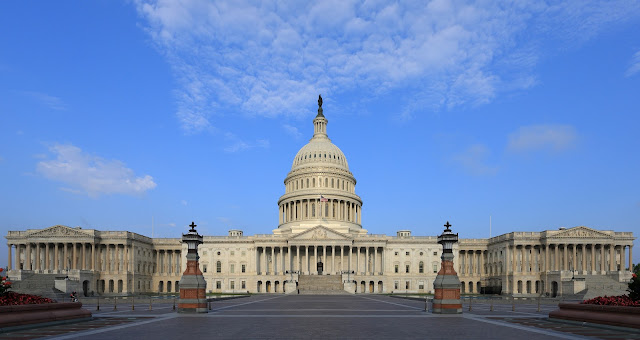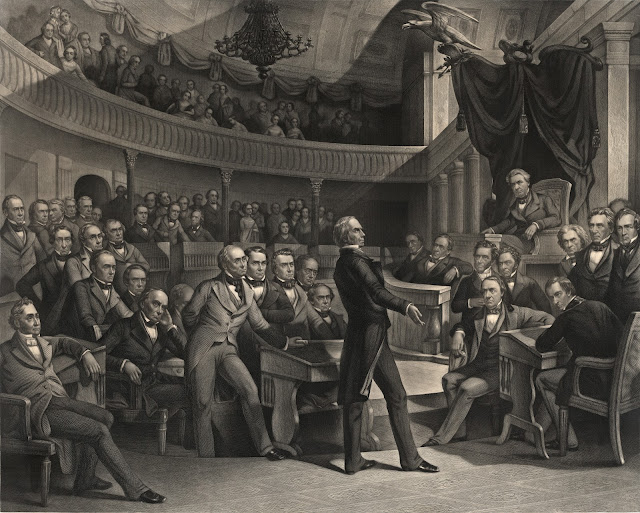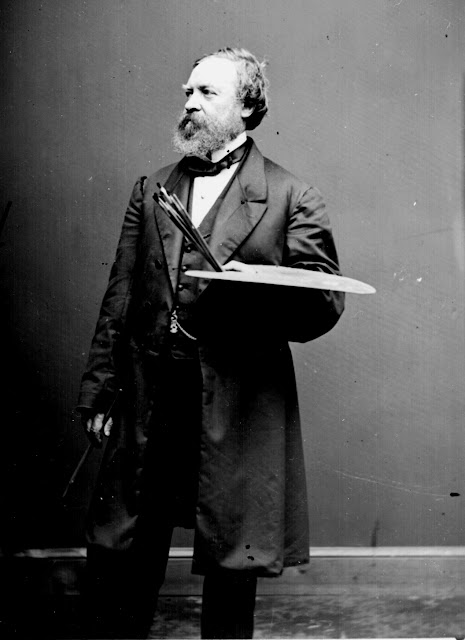The oldest functioning legislative building in the world that I'm aware of is the US Capitol first built 1793 - 1800. It's much older than Germany's old Reichstag building 1884 - 1894, and older than the current Palace of Westminster (The Houses of Parliament) built 1840 - 1876. The US Capitol is a first of its kind building that has no real precedent, at least not since ancient Rome. It is the US Constitution (the world's oldest functioning constitution) rebuilt in stone and iron with two wings for both houses of Congress joined by a great dome, once a metaphor for the heavens and now remade as symbol of popular sovereignty.
A print from 1834
George Washington described the proposed new legislative building in the new capital city named for him as a "Temple of Liberty." Washington called it a "capitol" after the Capitoline hill in Rome. As the ancient Temple of Jupiter once stood on that hill in Rome, so the American "Temple of Liberty" would stand on its hill, a Capitol facing east toward the rising sun.
William Thornton's winning design from the competition for a design of the new capitol.
George Washington laid the cornerstone for the new Capitol September 18, 1793 in a Masonic ceremony.
By 1800 when this print was made, only the Senate wing of the Capitol had been completed.
The Capitol in 1814 after it was burned by the British in retaliation for the American destruction of York, Ontario (today Toronto) in 1813 during the War of 1812.
Benjamin Henry Latrobe and Charles Bulfinch designed the rebuilt Capitol.
The Hall of Columns in the House wing with columns designed by Latrobe using native commercial plants of North America.
One of Latrobe's tobacco leaf column capitals in the Hall of Columns.
A corncob capital designed by Latrobe.
The old House chamber, today Statuary Hall.
Samuel Morse's painting of the US House in night session from 1822.
Clio the Muse of History by sculptor Simon Willard from the House chamber recording the proceedings.
It is among the oldest sculptures in the Capitol installed in 1837
The old restored Senate Chamber, used from 1864 to 1935 as the Supreme Court.
PF Rothermel engraved by R. Whitechurch, The United States Senate, AD 1850, published c1855.
Henry Clay introduces the Compromise of 1850 in the old Senate Chamber. Also appearing in this print are Daniel Webster and John C. Calhoun.
The earliest surviving photograph of the Capitol from 1846
The photo shows the wood and copper dome designed by Charles Bulfinch.
Alexander Jackson Davis' drawing of Bulfinch's original rotunda of the Capitol.
Most of Bulfinch's original construction still forms part of the rotunda today.
A photograph taken during a recent restoration of the iron construction of the domes of the Capitol.
In the 1850s, the Capitol expanded to accommodate a rapidly growing USA creating an ever larger Congress. Congress commissioned Philadephia architect Thomas Ustick Walter to more than double the size of the Capitol that became cramped and crowded with Representatives and Senators from newly admitted states.
Walter's first design for the expanded Capitol from about 1849.
Walter's second design, still incorporating Bullfinch's dome.
Bullfinch's wooden dome was a fire hazard and needed constant repairs. Architect Thomas Walter insisted to an always parsimonious Congress that the newly expanded Capitol design needed an appropriately sized centerpiece. He drew up a proposal for a much taller dome of cast iron. Walter's single proposal drawing created such a sensation in Congress that they skipped the usual committee hearings and debates and voted to build it in 1854 with the approval of President Franklin Pierce. Construction began over Bullfinch's old rotunda in 1855.
Thomas U. Walter's design for the dome.
Thomas U Walter's cutaway view of the dome showing the proposed cast iron construction of a double shell dome using the precedent of Sir Christopher Wren's dome of St. Paul's Cathedral. St. Paul's dome is a double shell dome built around a great brick cone that holds up the lantern at the top. Walter also used the precedent of Jules Hardouin- Mansart's dome of the Dome des Invalides in Paris, a dome built of stone with an outer dome of lead supported by a wooden framework.
Walters wanted something much more than engineering advice from early architecture. He wanted to build something that would take all the previous history of dome construction and remake it all for a new purpose for the future. He used for inspiration not only Wren's St. Paul's but the precedents of dome design going back to Michelangelo's dome for St. Peter's and more directly Bramante's Tempietto. He also used the precedent of medieval Islamic Persia that pioneered double shell dome construction. And most of all, Walter quotes the most famous ancient dome, the dome of the Pantheon in Rome from the first true republic of the ancient world, claimed by the founders of the USA as a predecessor. This dome resting on so much historic precedent would be made from an industrial material, cast iron. Walters uses all of history to declare a new order of the world in a modern material.
The US Capitol was among the first major buildings to secularize the dome. Domes adorned religious buildings for centuries as metaphors for the heavens. The Capitol transformed the dome into a metaphor for popular sovereignty using the circle as an emblem of equality and the dome of the heavens as equally encompassing all beneath. It's a symbol of who the legislature serves, of who according to the Constitution and the founding documents is supposed to be truly supreme in the land, all of the people together regardless of rank or distinction.
Thomas U. Walters' final design for the US Capitol.
Construction of the Capitol in 1854.
Construction in 1860
The Capitol under construction on March 4, 1861 with Lincoln's first inauguration taking place below.
Capitol construction in 1862
Capitol construction in 1863
Federal troops guarding the Capitol construction site.
When the Civil War broke out in 1861, generals and politicians both urged Lincoln to suspend construction of the Capitol dome and use the iron, manpower, and money for the war effort. Lincoln refused and ordered the construction to continue as an act of faith in the victory and durability of the union of the states. He turned the dome into a testament declaring that the country "conceived in Liberty and dedicated to the proposition that all men are created equal" would endure.
The builders of the Capitol before the Civil War used slave labor rented from nearby plantations at every stage of construction from quarrying to finishing. The labor of enslaved people included carpentry and masonry, both brick making and brick construction. Much of this was skilled labor. Among such skilled laborers was Phillip Reid who became something of a skilled bronze founder for the sculptor Clark Mills charged with casting Thomas Crawford's statue of Freedom at the top of the Capitol dome.
After the start of the Civil War, Capitol construction employed African American laborers who frequently were paid less than white workers for the same labor.
Thomas Crawford's statue of Freedom installed in sections on the top of the dome in 1863.
The Capitol dome completed in 1863.
The interior of Thomas Walters' cast iron dome of the US Capitol
with Constantino Brumidi's Apotheosis of Washington in the oculus at the top.
Brumidi's Apotheosis of Washington in the top of the dome completed in 1869
After the dome was completed in 1863, Congress in 1865 commissioned Constantino Brumidi to paint a glorification of George Washington in the oculus of the dome. The original builders of the Capitol planned to use the rotunda as a burial monument for Washington. When he died, Washington's wishes to be buried at Mt. Vernon were respected. The rotunda remained a memorial for Washington. Brumidi approached this project with that history in mind.
Many people protested against Brumidi's appointment for this project. He was a foreigner, an Italian immigrant with a then suspiciously radical political past. Brumidi, a native of Rome, participated in the short-lived Roman Republic uprising against the rule of Pope Pius IX over the city. He fled the city when French troops in the service of the Pope arrived to put down the rebellion. Bumidi arrived in the USA and became a naturalized citizen in 1852. Brumidi had his champions who resisted the nativist xenophobia on his behalf. Another reason Brumidi kept his job was that he was the only man in the Western Hemisphere who knew how to fresco a large interior surface and had experience doing it. He was an artist in Rome specializing in large scale fresco painting for churches, public buildings, and theaters. Some of his work in Rome survives. He did the same for churches in Mexico and in the USA (most notably in St. Stephen's Catholic Church in New York City). And so, a Roman artist painted a Roman scale fresco of a very traditional Roman ceiling apotheosis in the summit of the Capitol of the United States.
Using the visual language of Catholic Baroque Rome, Brumidi created a very secular non-sectarian glorification of Washington's memory. Instead of angels and saints, or muses and gods, Brumidi paints personifications of the original 13 states together with Roman gods standing in for commerce, manufacturing, agriculture, etc. Very old (and rapidly becoming obsolete) allegorical language used to proclaim the creation of a new modern world.
A photograph to give an idea of the size of Brumidi's work. The larger figures in the fresco are 15 feet tall.
An early proposal for the oculus fresco by Brumidi
The final proposal for the Apotheosis of Washington by Brumidi
Constantino Brumidi
I present all this material on the US Capitol for a reason. Today is the first anniversary of the January 6, 2021 attack on the Capitol, the worst violence the building suffered since 1814 when British troops burned it down. The Capitol is the people's house. It belongs to all of us no matter who or what or where we are. It's our house as individuals and as communities. The people who broke in and trashed the place attacked the very claim we all hold on that building. They trashed the very history that shaped the Capitol, a history that is our history including founding fathers, the enslaved, soldiers. and immigrants.
I never imagined that I would see something so shocking as the Confederate battle flag paraded through the halls of the Capitol. As far as I'm concerned it's all of a piece with rioters shitting in the halls and smearing it on walls built by slaves and adorned by immigrant artisans.
Something else I never imagined seeing on the Capitol grounds, an improvised gallows intended for the murder of the Vice President and members of Congress.
The MAGA putsch failed a year ago today because so many people did their duty and fulfilled their oaths of loyalty to the Constitution of the United States. Police, soldiers, and Capitol staff did their duty and repelled an attack on the Congress of the United States in an effort to stop the lawful certification of the 2020 Election results.
The people who attacked the Capitol a year ago believed that they are the only people who matter and their votes are the only ones that matter. The rest of us just don't count including our votes. They wanted to force a result onto all the rest of us who chose otherwise. These self-proclaimed super patriots tried to overthrow an election result, and with it the government of the United States. They want to replace it with a racial and sectarian dictatorship founded on white Christian supremacy. They want to replace the United States and its democracy with a Holy American Empire ruled by themselves and for themselves at our expense.
This was a rebellion of magical thinking against the tyranny of reality. So many of these rebels chose to live in the world of conspiracy theories where elephants hide in treetops everywhere and the reason you can't see them is because they are so effective at hiding. Evidence gets dragooned into proving preconceptions and forbidden to speak for itself. They chose this world because it tells them what they want to hear. The once staunch defenders of absolutism in matters of morals have now become the worst moral relativists whose blatant ends-justify-means hypocrisy shocks and offends everyone except themselves. A lot of money and labor went into building this ugly paranoid fantasy world. More money gets spent keeping its faithful believing in it with all their hearts and minds.
Reality has its own integrity regardless of what any of us think about it. It always bites us no matter how hard we twist it or ignore it. A willingness to engage with what is real as opposed to what is imagined is a bedrock of democracy and of any decent society that anyone in their right mind would want to live in.
Vigilance is the price of democracy, and never more so than now as peoples around the world rise up to throw off ancient despotism for that fragile novelty of democracy that gives each and all of us freedom and dignity. A second putsch is inevitable and we must be ready to face it and defeat it.
The Capitol at dawn in 2016












































No comments:
Post a Comment